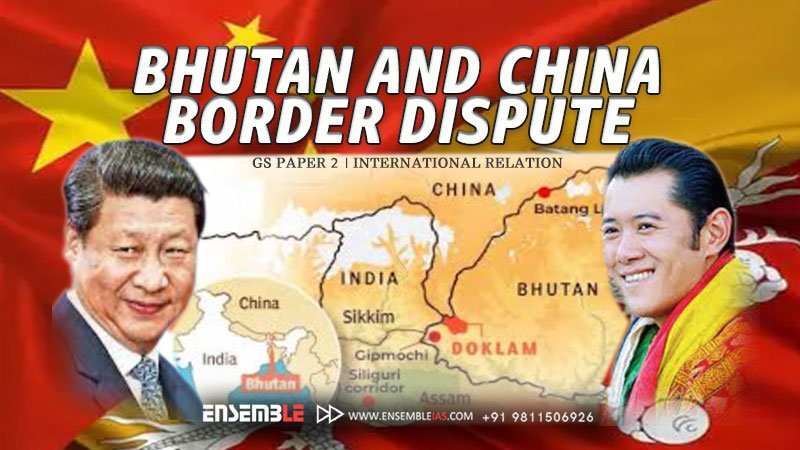Why in the News?
- Joint press releases of the 13 experts group meeting on 23 October held in China to end the Bhutan and China border dispute.
- “Cooperation Agreement” was signed by both countries during the 25th session of border discussion pending since the last round in 2016). This agreement is about establishing the roles and activities of the Joint Technical Team (JTT) on the delimitation and demarcation of the two countries’ borders.
- The boundary talks were led by Dr Dorji, Bhutan’s Minister for Foreign Affairs and External Trade, and Sun Weidong, China’s Vice Foreign Minister. It stated that both parties agreed to build on the positive momentum and signed a “Cooperation Agreement” to continue working together to simultaneously push forward the implementation of all three steps of the Three-Step Roadmap.
- China offered Bhutan to seize border issues and set formal diplomatic relations.
The link to join the course : Online Courses
What is the China-Bhutan Border?
- The Doklam Plateau, or Donglang in Chinese, is the central focus of the boundary dispute between China and Bhutan. A strategically important region, the Doklam Plateau is situated where China, Bhutan, and India converge. China and Bhutan both have rival territorial claims in this area.
- China started a boundary issue in 1984 and it took 25 rounds of talk and 13 rounds of EGM to conclude.
- China claims about 269 sq km in western Bhutan-Doklam and 495 sq km in the north-central parts of Bhutan. As of 2020, China has also begun to claim 740 sq km of the Sakteng Wildlife Sanctuary border.
- China wants the boundary drawn at Mount Gip Mochi, whereas India and Bhutan want the boundary drawn from Bantangla to Merugla and Sinchula.

Cooperation Agreement: – A “Cooperation Agreement” is a formal, legally binding treaty between governments that sets the terms and circumstances for cooperation and collaboration in a variety of areas of mutual interest. Governments often sign these agreements, which serve as a framework for strengthening bilateral or multilateral cooperation. As China -Bhutan cooperation Agreement has become a hot topic for India.
Tri-junction: – Doklam is a junction point between India, China and Bhutan. Siliguri corridor or chicken neck
Expert Group Meeting (EGM): – A meeting of experts is a gathering of individual specialists from various domains such as academia, government, civil society, United Nations, or other regional and from other countries to discuss international issues.
Joint Technical Group: – In the context of China-Bhutan meetings, the term “Joint Technical Group” (JTG) most likely refers to a working group or mechanism designed to promote technical exchanges and conversations between China and Bhutan on issues of their shared borders, particularly the settlement of their border dispute. Experts, surveyors, and government representatives from China and Bhutan usually convene as the Joint Technical Group (JTG) to deliberate and analyse the technical aspects of border demarcation and delineation.
Why should India be Worried?
- China already has border issues with 14 countries and issues have been sorted out in all countries after the Bhutan meeting except India because of the Doklam border.
- Bhutan Diplomat relations with China
- The Doklam Border
- After the 2017 standoff at the Doklam border between China and Indian soldiers.
- Earlier China has proposed to surrender the previously claimed north-central territories in exchange for keeping the Doklam boundary.
- As per India’s view China was forcing Bhutan to withdraw a boundary to bully New Delhi.
Conclusion: – It can be concluded that Bhutan has not made any official statement regarding the Doklam border dispute with China, even after the agreement between the two countries. However, this situation appears to be unfavourable for India as they believe that China is coercing Bhutan to withdraw its boundary to intimidate New Delhi. China’s clear intention in this move is to gain control over Doklam and exert pressure on Bhutan.
Best Online Coaching for Civil Service_IAS_ UPSC_IFS_IPS
Free Study Material ENSEMBLE IAS ACADEMY | Call +91 98115 06926 | Visit us:- https://ensembleias.com/ | Online Store: https://online.ensemble.net.in/
#international_relations #chinabhutanrelations#trendsingeography #explorepage #chinaIndiarelation #Upsc_current_affairs #Indiangovt #GSPaper2 #UPSC #ias #upsc_exam #civilservices #civil_services_study #ensemble_ias_academy #geography_optional #ias #upsc_exam #civilservices #upsc_motivation #upsc_aspirants #trendsingeography





